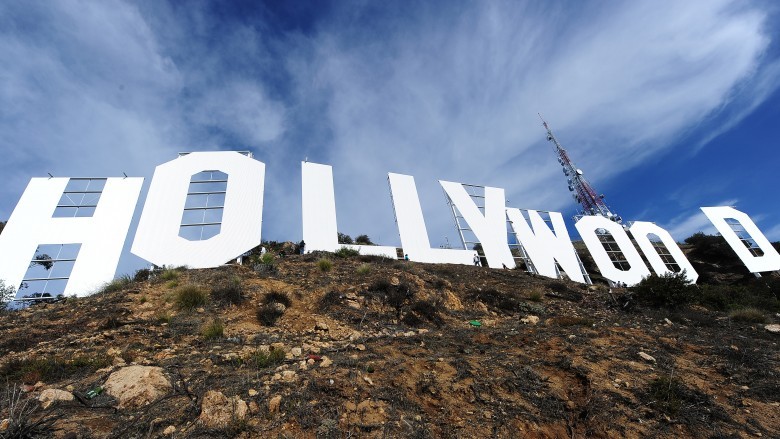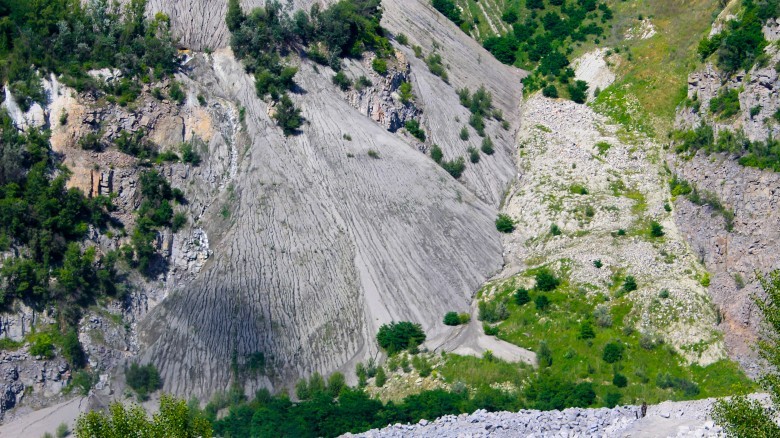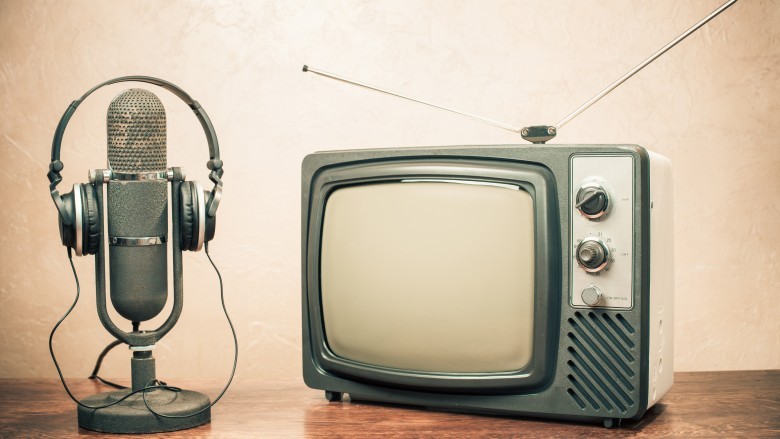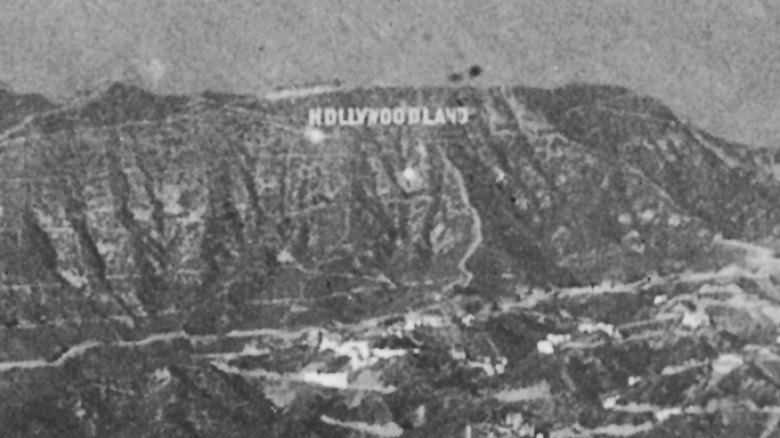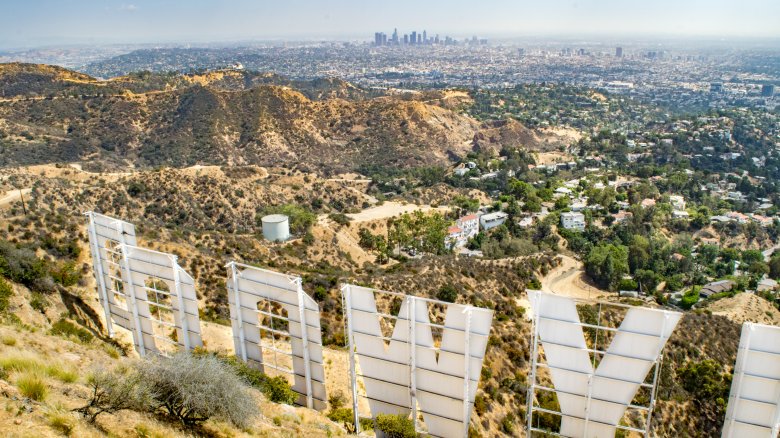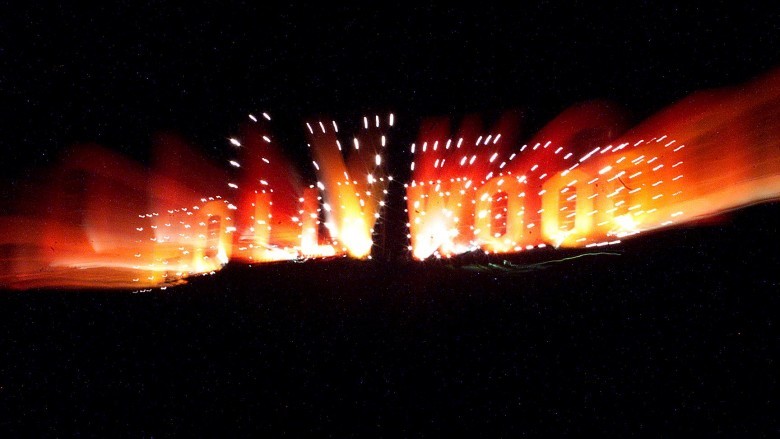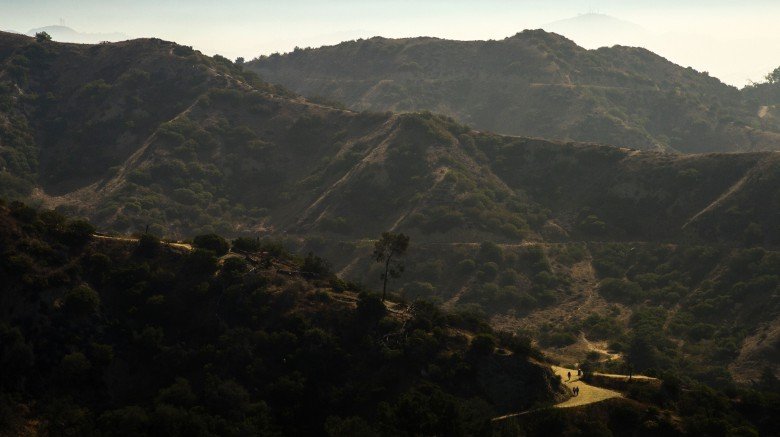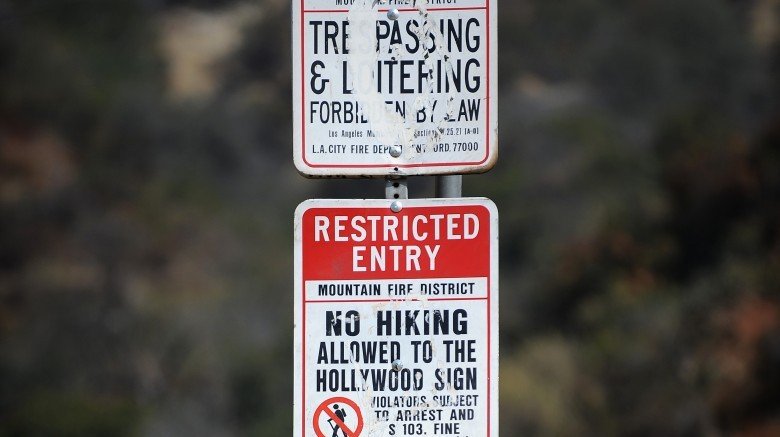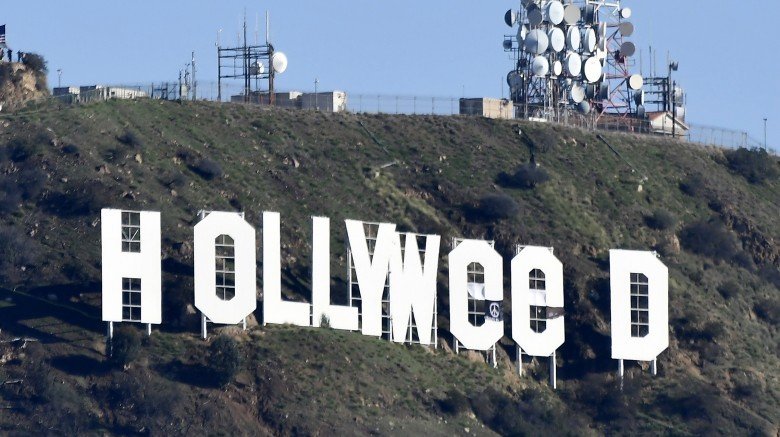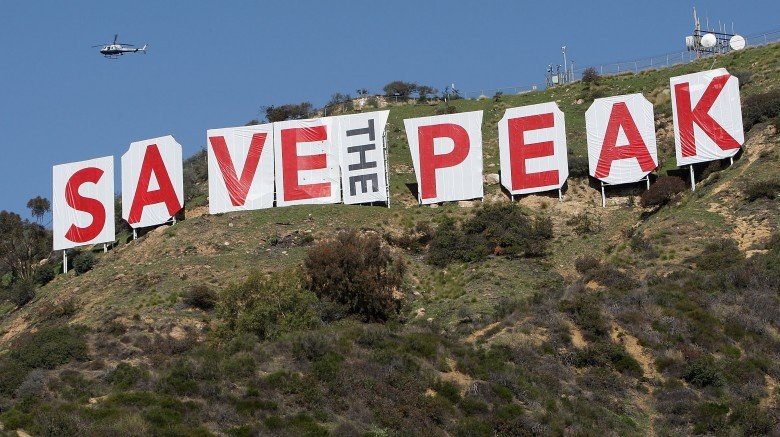The Untold Truth Of The Hollywood Sign
Outside of beaches and a plethora of kale, Los Angeles's most notable landmark is the Hollywood sign. Though it seems like the emblem would have a pretty simple history—a place named Hollywood put up a sign that said "Hollywood"—there's a lot you might not know about those big letters.
The original land was used as a granite quarry
Before the sign was built in 1923, the area around the Hollywood sign wasn't terribly glamorous. Eli Clark and Moses Sherman built the original streetcar lines and thought it would be smart to buy up the property around it. So the businessmen purchased the area that would one day house the Hollywood sign in 1905. They figured, "Who cares about houses in this burgeoning town of Hollywood. Let's just use this land for its sweet, sweet granite."
It stayed a quarry for years and was occasionally used as an outdoor theater. All in all, keeping major development off the land made the area the perfect place for one of LA's biggest landmarks.
The sign sits on Mt. Lee, named after the man who briefly had a studio there
The physical location of the Hollywood sign isn't called "Hollywood sign hill" or "difficult to get to tourist mountain." It's called Mount Lee. In the early days of the entertainment industry, pretty much any guy with money could try to be a studio mogul. So successful Cadillac salesman Don Lee got into radio in 1926. The car man did well in radio and in 1930 branched out into the very new technology of television.
From a studio perched above his Cadillac dealership, Lee broadcast the first soap opera and first news story in the country. The Don Lee Network wanted to expand and bought some land right behind the Hollywood sign. With the help of Mack Sennett, the Keystone Cops creator, they built a 300-foot tower 2,000 feet above sea level, the highest in the nation at the time.
The studio produced over two hours of television a day. That sounds lame, but it was very impressive for the era. Then when World War II rolled around, studios found that other hillsides had a greater range of frequency. So, all TV left Mt. Lee, though the site still bears his name.
The sign was originally Hollywoodland to promote a real estate development
You'd probably figure the Hollywood sign was built to make it abundantly clear that Hollywood was something you should shout hooray for. But it was just an advertisement. A group of real estate developers, including Harry Chandler of the LA Times and the appropriately named Hollywood Real Estate Group, created a residential area to fulfill the needs of the burgeoning entertainment business. It didn't hurt that Chandler could provide ample positive press for the community and publish it in the Times for free. But that wasn't enough advertisement. They wanted more.
So, after $21,000 spent on wood and mules (mules hauled all the materials up the mountain), people could read the sign from the city below: "Hollywoodland." It wasn't an expensive typo. Originally, Hollywood was called Hollywoodland. Since it was a little hamlet created in a cute and quirky throwback style, they went with a name that reflected those fairy tale ideas. Now, everyone could see that the new Hollywoodland was ready for residents.
The sign fell into disarray until it was saved in 1978 by celebrities
The one part of Argo that was true was that the Hollywood sign was once a deteriorating mess. The first Hollywoodland sign was never meant to be permanent. The landowners figured they'd get attention then pull it down, just like you'd do with a regular billboard. But it became a beacon of Tinsel Town, and in 1949, the city decided to maintain the sign, though they did take down the "land" part. Who wants to keep up a third L?
By the early '70s, the city was behind on upkeep. British architectural professor Reyner Banham said in 1972, "Los Angeles needs some guidance, because it's normally regarded as an unspeakable, sprawling mess." The city declared the sign a Los Angeles Cultural-Historical Monument in 1973, but they still needed money to replace the decaying landmark. In perfect Hollywood fashion, celebrities saved the day.
In 1978, Hugh Hefner, of Playboy fame, hosted a massive fundraiser. Celebrities ceremoniously bought letters for $28,000 each to keep the sign up for years to come. Gene Autry, Andy Williams, and Hefner himself contributed. But it wasn't just the old guard protecting the sign—singer Alice Cooper bought an "O" of his own.
This time, the new sign wasn't made with wood and mule power but had a base of steel with corrugated baked enamel letters individually flown in by helicopter. It's been standing strong since and even got a new coat of highly reflective white paint so it shines as brightly as a movie star's smile.
The sign doesn't light up, but that hasn't always been the case
With all the renovation, you'd think they'd pop a couple of lights on the sign. It's rare for such an iconic city piece to be completely invisible after sundown.
Well, once upon a time, the sign did light up. The very first version in 1923 was lined with bulbs. The letters would flash out the words separately, so the sign would read "Holly," "Wood," "Land," then the whole thing would light up to say "Hollywoodland." Of course, since the sign wasn't mean to stick around, by the time "Land" was taken down, all the bulbs were destroyed or stolen.
Since then, they don't even have flood lights to shine up the sign. But they have lit it a couple of times. Occasionally for film shoots, they'll light up the sign to give people a cool movie moment that almost never happens in real life. Then for the 1984 Olympics in Los Angeles, the city thought it was worth it to illuminate the sign just to show the world how cool it can look at nighttime. But the biggest lighting event was December 31, 1999.
In Los Angeles, there's no central, iconic place for a celebration, like the Space Needle in Seattle or the Ball Drop of New York. So, to celebrate the new millennium, Los Angeles put on a big light and laser show at the Hollywood sign. Since it was so rare to see the letters lit up, you'd figure it would attract an outstanding crowd. But, because it rained slightly earlier in the day, the turnout was very disappointing. The people of Los Angeles pretty much have Wicked Witch disease, where rain will cause them great stress and potential melting, so they couldn't risk the rain to celebrate the year 2000. Since then, there've been no major light-ups, and the time for laser shows is probably over for good.
An actress supposedly haunts the sign
Peg Entwistle was a very successful stage actress in New York in the late 1920s, when she started to suffer from a variety of misfortunes. Her new husband "forgot" to tell her he had been married before, had a drinking problem, and had a child. The husband, who she worked with in a stage touring company, started getting into trouble by showing up drunk, and he often asked Peg for more money. Eventually, his alcoholism was overwhelming, and Peg left him. Though she wasn't the problem, her onstage peers started looking down on her for all the trouble her husband caused.
She moved back to her hometown of Hollywood and tried to get work. Though she got some small parts, nothing really worked, but she got a contract for a stage show on the east coast. Soon after, legendary producer David. O Selznick wanted Entwistle for a major role in a new film. So she broke her contract with the stage play and returned to Hollywood. She thought it would be her big break, but Entwistle's part in Thirteen Women was almost completely cut from the film.
She lost hope. In 1932, she jumped off the H of the Hollywood sign and died. Some people claim to feel the effects of her death to this day. Megan Santos was walking through Griffith Park near the sign in 2014 when she says she felt a general creepy vibe. She told Vanity Fair, "And then there was this woman with blond hair and she seemed to be ... walking on air." That's the best proof people have that Peg Entwistle haunts the sign, but she's been sighted near it since the 1940s. The ghost is described as female, blonde, and often dressed in '30s clothing, smelling greatly of gardenias. According to Vanity Fair, Entwistle loved a gardenia-scented perfume.
If you or anyone you know is having suicidal thoughts, please call the National Suicide Prevention Lifeline at 1-800-273-TALK (8255).
A severed head was found near the sign
Though Entwistle was the only person to jump off the sign, she's not been the only body found beneath the letters. A dog walker was taking a stroll near the sign in 2012, when he saw something strange in the path. Turns out it was a severed head wrapped in a 99-cent store bag. Good to know that insane murders are also thrifty.
Gabriel Campos-Martinez, 40, strangled his boyfriend Hervey Medellin, 66, when he found out that Medellin was going to break up with him. Martinez killed him in late December 2011, and cops couldn't track him down till March 2014, where they found Martinez living in Texas with his wife, whom he'd married the year before. Though he's never said why he dismembered the body and dumped it by the sign, Martinez showed no remorse and is now serving a 25-to-life sentence for his crimes. Perhaps don't pick the most memorable location in Los Angeles when you're dumping a body.
It's not easy to get near the sign
With the tragic tales and popularity of the Hollywood sign, you'd figure it's as easy to get to get up close to it as it is easy to get harassed by a fake Spiderman outside the Chinese theater. But walking up to the sign is quite a task. Roads don't go there, so a casual drive won't get you a front-row view. The Hollyridge path is the most popular way to get there, but it's a full 1.2-mile hike (one way) that lets you look down upon the sign. Though that path and others are available, the neighborhood surrounding them is trying to make it even more difficult to the sign.
The homeowners in the Beachwood Canyon hate that tourists take up local parking, make noise, and want to enjoy anything around where they live. They've put up fake signs to ward off hikers, tried to get the city to restrict parking in the area, and convinced Google to reroute the directions to the Hollywood sign. In their dream world, the neighborhood would have the city shut down the Hollyridge pass completely. To be clear, these aren't homeowners who lived in the area before the sign was born. It's people who chose to move right next to one of the biggest tourist destinations in the city. But they never imagined that so many tourists would be there!
All the current paths take you to a viewing spot above the sign. But what if you want to touch the letters themselves? You can't. It's illegal to walk up to the sign or touch or climb the sign in any way. The previous paths became eroded, and the area is so dry, hikers present a serious fire hazard.
The sign has been vandalized to give another message quite a few times
Even though it's hard and illegal to go up to the sign, that hasn't completely stopped people. The sign has been altered a bunch of times to read, "Jolly Good," "GO NAVY," "Sallywood," and once an unknown band called the Raffey's changed it to RAFFEYSOD (it didn't help their career). But one group has pulled off the highest number of alterations.
In 1976, Danny Finegood and friends altered the sign to read "Holywood" on Easter Sunday, just a bit of festive vandalism. In 1987, the group struck again, making the sign say "Ollywood" in protest of Oliver North in the Iran-Contra scandal. But the piece de resistance was his work in the middle of the night on January 1, 1976. Finegood and his friends made the sign read "Hollyweed." Get it, man?
The group didn't pull the stunt just to make their stoner friends laugh, but to celebrate the new legislation that relaxed marijuana possession laws in the state. "Hollyweed" was so great, a different trickster altered the sign again on January 1, 2017. This time, it was to commemorate California's legalization of weed and fill the area with pot paraphernalia as quickly as possible.
The sign was threatened again in 2010 and saved again by Hugh Hefner
A great thing about the Hollywood sign is that it isn't surrounded by mansions or condo complexes. It's just the sign on a hill with beautiful simplicity. But given that real estate is out-of-control expensive in Los Angeles, it was only a matter of time before someone tried to put in some housing complexes. A Chicago developer owned the land and planned on filling the peak just west of the sign with luxury homes in 2010. If Los Angeles rallies to keep away anything with the word "luxury," you know it's an important cause. The state was able to free up some money to purchase the land for the city but missed the mark by close to $1.5 million.
Fortunately, Aileen Getty and the Tiffany company ponied up $500,000, and the true Hollywood sign hero came through once again. That's right: Hugh Hefner donated almost a million dollars to keep the sign and its peak untouched. It looks like pornography is good for culture after all.
